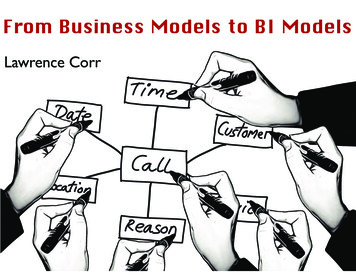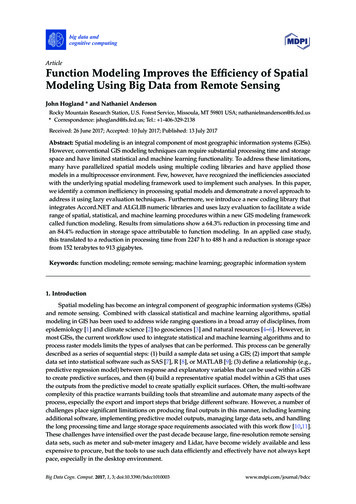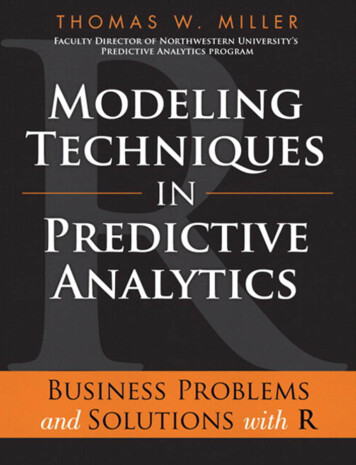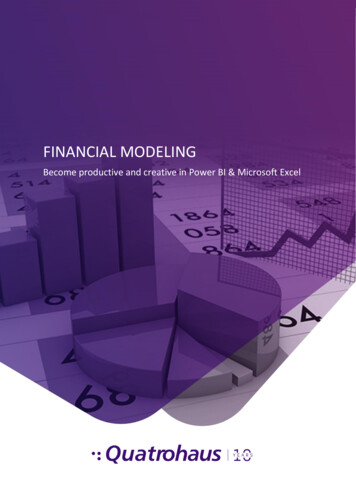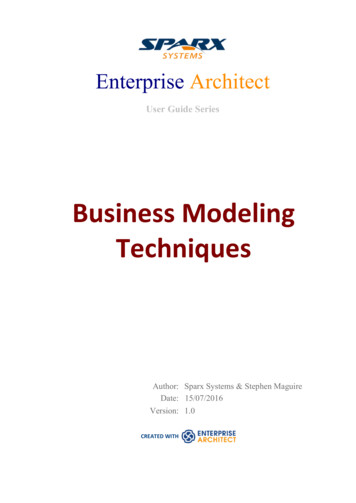
Transcription
Enterprise ArchitectUser Guide SeriesBusiness ModelingTechniquesAuthor: Sparx Systems & Stephen MaguireDate: 15/07/2016Version: 1.0CREATED WITH
Table of ContentsBusiness Modeling TechniquesStrategyBalanced ScorecardBenchmarking and Market AnalysisBusiness Capability AnalysisBusiness CasesBusiness Model CanvasOrganizational ModelingSWOT AnalysisCollaborationBrainstormingCollaborative GamesFocus GroupsInterviewsMind MappingWorkshopsAnalysisAcceptance and Evaluation CriteriaBusiness Rules AnalysisData MiningDecision AnalysisDocument AnalysisFinancial AnalysisInterface AnalysisNon-Functional Requirements AnalysisObservationProcess AnalysisRoot Cause AnalysisModellingConcept ModelingData DictionaryData Flow DiagramsData ModelingDecision ModelingFunctional DecompositionGlossaryProcess ModelingPrototypingSequence DiagramsState ModelingUse Cases and ScenariosUser StoriesProject ManagementBacklog ManagementEstimationItem TrackingLessons 505255575961626567697273767780828385878990929395
Metrics and Key Performance Indicators (KPIs)PrioritizationReviewsRisk Analysis and ManagementRoles and Permissions MatrixScope ModelingStakeholder List, Map, or PersonasSurvey or QuestionnaireVendor Assessment9798100101103104106114116
User Guide - Business Modeling Techniques15 July, 2016Business Modeling TechniquesEnterprise Architect provides a sophisticated and flexible Business Analysis modeling platform that can be used by theanalyst and others from strategic planning through to product support. It has extensive support for a wide range ofBusiness Modeling Techniques and allows these techniques to be used in isolation or together to create compelling andexpressive models that will delight audiences including high level executives and technology developers alike. Thetechniques can be used by any discipline including managers, architects, designers, implementers, testers and more butthey are particularly useful for the Business Analysts. This topic provides a description of fifty of the most commonlyused Business Analysis techniques and describes the most important tools that can be used to perform the technique withlinks to more detailed explanations about how to use the individual tools.It is conveniently aligned with the BABOK Guide v3 and so provides welcomed help for the Business Analyst andexplains practically how to use Enterprise Architect to perform the techniques described in the Guide. For example allanalysts will know the importance of Stakeholder modeling to the success of an endeavor but typically find it difficult toknow where to start and how to create useful models of how to communicate with stakeholders and to represent theirconcerns and interests in a model. The ‘Stakeholder List, Map, or Personas’ techniques lists more than ten tools that canbe used to help model stakeholders leaving the analyst free to choose whatever is most appropriate for their initiative.The following diagram shows the use of a Boundary element to create an Onion diagram representing the stakeholders’influence on an initiative.(c) Sparx Systems 2015 - 2016Page 4 of 118Created with Enterprise Architect
User Guide - Business Modeling Techniques15 July, 2016Stakeholder Onion DiagramAffected External StakeholdersKatherine Celta:Training PartnerOrganization or EnterpriseFelicity NewtonJones: HumanResources ManagerYukiko Miakawati:Chief Financial OfficerAffected Organizational UnitKarl Zimmerton:Development andImplementationManagerPaul Magnolia: TestManagerHamyln Piper: ChiefFinancial OfficerSolution DeliveryAndre Douglas:Chief TechnicalOfficerAlessandro Taglia:CustomerExperience ManagerToni Rothland: StockControl ManagerThis diagram indicates the level of involvement the stakeholders have with the solution, whichstakeholders will interact directly with the solution or participate in a business process, which arepart of the whole organization, and which are outside the organization.(c) Sparx Systems 2015 - 2016Page 5 of 118Created with Enterprise Architect
User Guide - Business Modeling Techniques15 July, 2016StrategyStrategic thinking provides a plan for how an organisation needs to adapt in the context of a changing and oftencompetitive environment, typically caused by disruptive business and technology forces. Strategic techniques help theanalyst to discover, analyse and communicate the strategic concerns of executive level stakeholders. The resultingmodels and artifacts will form the context for all other analysis work allowing analysts to understand the business reasonfor an initiative. Enterprise Architect provides a wide range of tools that can be used to perform the Strategic techniquesthese include tools such as the Balanced Scorecard, Business Cases and Organisational modelling all of which can belinked to the opportunity and solution models allowing traceability from the executive level right through to theimplementation artefacts that describe a solution.(c) Sparx Systems 2015 - 2016Page 6 of 118Created with Enterprise Architect
User Guide - Business Modeling Techniques15 July, 2016Balanced ScorecardBalanced Scorecard is a strategic planning and monitoring mechanism to ensure that business activity aligns withstrategic goals and where it is found not to align to adjust the business activities in an attempt to improve performance.The idea was originally expounded by Robert Kaplan and David Norton as a performance measurement framework thatcreated a more 'balanced' view of organizational performance by adding a number of non-financial performancemeasures to traditional financial metrics. It was discovered that just focusing on financial measures was not sufficient formodern enterprises in the information age and so three additional measures were added. The balanced scorecard suggeststhat an organization should be viewed from the following four perspectives:····The Learning & Growth PerspectiveThe Business Process PerspectiveThe Customer PerspectiveThe Financial PerspectiveMetrics should be defined for each perspective and data collected and analyzed on a regular and ongoing basis to providethe information required by managers to intervene by adjusting business activity in an attempt to increase performance.Enterprise Architect has a useful extension for strategic modeling which allows a series of strategic diagrams to becreated including a Balanced Scorecard. Like many of the strategic diagrams a Balanced Scorecard can be convenientlycreated from a diagram pattern available from the Strategic Modeling toolbox group.(c) Sparx Systems 2015 - 2016Page 7 of 118Created with Enterprise Architect
User Guide - Business Modeling Techniques15 July, 2016Financial PerspectiveHow should we appear to our shareholders?- Broaden Revenue Base- Improve Operating Efficiency- Reduce Reliance of Domestic Customers«SM Effect»«SM Effect»«SM Effect»Business Process PerspectiveWhat Business Processes must we excel at?- Move to Internet Channel- Reduce Processing Time- Broaden Product Offering- Understand Customer SegmentsCustomer PerspectiveHow should we appear to our Customers?«SM Effect»VISION&«SM Effect»STRATEGY- Product Range- Service Excellence- Innovative and Reliable- Trusted Business Partner«SM Effect»Learning & Growth Perspective«SM Effect»How can we maintain our ability to changeand improve?- Increase Employee Job Satisfaction- Increase Employee Productivity- Hire Internet Aware Technical Staff- Hire multi-Channel Sales Executives«SM Effect»The Balanced Scorecard diagram is partof the Strategic Diagrams used bymanagers and others to manageactivities performed by the staff undertheir control.The following section lists the main tools available in Enterprise Architect that can be used to perform this technique.There are also a wide range of additional tools that a modeler may find suitable when applying the technique in aparticular context. The complete list of tools is available from the topic ‘Business Modeling Tools’.Balanced Scorecard DiagramA Balanced Scorecard Diagram can be created at any level from an organization level though to an initiative (project)level and any number of diagrams can be created. The diagrams and the elements they contain can be placed into apackage at appropriate levels in the Project Browser. The Toolbox page for the diagram comes with a time savingBalanced Scorecard pattern that can be used to create the elements and the diagram ready for the analyst to complete. Allfour dimensions are supported and Objectives, Measures, Targets and Initiatives can be added as text and formatted asrequired.Learn More: Balanced Scorecard DiagramDocumentationEnterprise Architect has a powerful and flexible documentation generator that can produce Docx and RTF WordProcessor files, PDF and HTML reports. Any Balanced Scorecard stored in the repository can be conveniently generatedand included in documentation. The formatting used to describe the Objectives, Measures Targets and Initiatives can alsobe carried through to the documentation. A sophisticated template facility exists that provides a range of in-builttemplates and allows the user to create their own templates, defining styles, images and a wide range of other formatting(c) Sparx Systems 2015 - 2016Page 8 of 118Created with Enterprise Architect
User Guide - Business Modeling Techniques15 July, 2016options.Learn More: DocumentationBaselinesThe Baseline Tool is used as a type of backup and recovery tool and can capture a snapshot of the Balanced Scorecard ata point in time and then at a later time the repository can be compared to this (or another baseline) for the purpose ofdetermining what has changed. It is possible to revert the current model back to a state captured in the baseline at thelevel of a granular change.Learn More: Baselines(c) Sparx Systems 2015 - 2016Page 9 of 118Created with Enterprise Architect
User Guide - Business Modeling Techniques15 July, 2016Benchmarking and Market AnalysisEnterprise Architect is a flexible platform that can be used to assist the analyst with both Benchmarking and MarketAnalysis as it has convenient tools for recording research finding and has the ability to express these in diagrams anddocumentation generated from the model. Request for Information (RFI) documents could be generated directly from themodel and the powerful Relationship Matrix can be used to demonstrate gaps between current and best practice.Titles R Us Online BooksnotesThis organization has no history of being a bookseller with physical retail outlets. They emergedas an online book store when the web becameubiquitous and quickly rose to be a leadingplayer in online sales.This diagram shows the results of competitoranalysis listing the significant features thatdifferentiate their service. An aggregationrelationship has been used to associate thefeatures with the class representing thecompetitor.Birthday Gift Vouchers for Valued MembersnotesThe competitor has a program of birthday gift vouchers delivered at onthe eve of a valued member's birthday. The vouchers are valid for a yearand their value depends on the value of the member but typically rangefrom 20 - 80. This feature is dependent on the member providing theirbirthday.Buy Five Books and Get One FreenotesThe competitor gives an additional book for free when a customerpurchases five books. The free book is the cheapest one in the group offive. This sales device encourages customers to purchase more booksand creates goodwill.Weekly New Release PagesnotesThe competitor has a new releases page for each major category ofbooks offering discounts for the first 100 purchases of selected items.This feature encourages customers to return to the web siteperiodically to check for new releases at discounted prices.The following section lists the main tools available in Enterprise Architect that can be used to perform this businessanalysis technique. There are also a wide range of additional tools that a modeler may find suitable when applying thetechnique in a particular context. The complete list of tools is available from the topic ‘Business Modeling Tools’.Relationship MatrixThe Relationship Matrix is a powerful and compelling tool for visualizing the relationships between two sets ofelements. Business Capabilities can be related to a number of different sets of elements including Use Cases, UserStories, Functional Requirements and Business Processes. A number of different Matrices could be created with theBusiness Capabilities on one axis and a different set of elements on the other axis in each of the matrices. The Matricescan conveniently be saved as resources and also exported to a Spreadsheet file.Learn More: Relationship Matrix(c) Sparx Systems 2015 - 2016Page 10 of 118Created with Enterprise Architect
User Guide - Business Modeling Techniques15 July, 2016StereotypingA Business Capability is not defined as an element type in any of the built-in Toolbox palettes but can be created as atype using the Unified Modeling Language (UML) extension mechanism of Stereotypes. The defined Stereotype canthen be applied to a Class to create a Capability that can be added to the model.Learn More: StereotypingDocumentationEnterprise Architect has a powerful and flexible documentation generator that can produce Docx and RTF WordProcessor files, PDF and HTML reports. Benchmarking and Market analysis diagrams and elements can be included inthe documentation, and Relationship Matrices can also be added. A sophisticated template facility exists that provides arange of in-built templates and allows the user to create their own templates defining styles, images and a wide range ofother formatting options.Learn More: Documentation(c) Sparx Systems 2015 - 2016Page 11 of 118Created with Enterprise Architect
User Guide - Business Modeling Techniques15 July, 2016Business Capability AnalysisCapabilities can be modeled in Enterprise Architect as part of the tool's support for Business Architecture. Thecapabilities can be modeled to determine how well the organisation is performing in its achievement of business goals orobjectives. The Relationship Matrix can be used to provide a clear view of how the capabilities are meeting current andfuture goals and objectives.The following section lists the main tools available in Enterprise Architect that can be used to perform this businessanalysis technique. There are also a wide range of additional tools that a modeler may find suitable when applying thetechnique in a particular context. The complete list of tools is available from the topic ‘Business Modeling Tools’.Relationship MatrixThe Relationship Matrix is a powerful and compelling tool for visualizing the relationships between two sets ofelements. Business Capabilities can be related to a number of different sets of elements including Use Cases, UserStories, Functional Requirements and Business Processes. A number of different Matrices could be created with theBusiness Capabilities on one axis and a different set of elements on the other axis in each of the matrices. The Matricescan conveniently be saved as resources and also exported to a Spreadsheet file. Overlays can be added to the matrix cellsexpressing things like the degree of compliance, effectively adding another dimension to the matrix.Learn More: Relationship MatrixRoadmap Diagram(c) Sparx Systems 2015 - 2016Page 12 of 118Created with Enterprise Architect
User Guide - Business Modeling Techniques15 July, 2016A Roadmap Diagram can be used to show how Capabilities change over time and to represent phases in the lifecycle ofthe Capabilities. The diagram has a Legend that is integrated with the elements on the diagram and can be used toexpress concepts such as Capability Definition, Acquisition, Support and Retirement. Colors can be assigned to thedimensions defined in the Legend and the time scale of the diagrams can be configured to suit the temporal scale of theCapability model.Learn More: Roadmap DiagramClass DiagramCapabilities can be modeled using a Stereotyped UML Class element. Stereotyping is one of the extension mechanismavailable as part of the UML and allows a type to be created that represents a Business Capability. These can be added toa Class Diagram and connected by aggregation relationships to show a tree of Capabilities down to any level. TheCapabilities can also have connections to a number of other elements including Goals, Objectives Applications and more.Learn More: Class DiagramProject BrowserA Business Capability Hierarchy can be created directly in the Project Browser without the need to create a diagram. AUML Class is a good way to capture the Business Capabilities of an organization and these can be created directly in theProject Browser. Additional Capabilities can be added under each first level Capability creating a second level. Thesesecond level Capabilities can have Capabilities nested under them creating a third level. The resulting tree of Capabilitiesprovides a useful way of describing Functional Decomposition that can be presented to and reviewed by stakeholders.Learn More: Project BrowserStereotypingA Business Capability is not defined as an element type in any of the built-in Toolbox palettes but can be created as atype using the Unified Modeling Language (UML) extension mechanism of Stereotype. The defined Stereotype can thenbe applied to a Class to create any number of Capabilities that can be added to the model.Learn More: StereotypingVisual FiltersVisual Filters can be used to hide or dim parts of the diagram so that other parts can be emphasized. This is particularlyuseful when presenting a Capability Model Class Diagram to a team in a meeting or demonstration. Context Filtering iseasy to setup and will emphasize the currently selected diagram element and its directly connected elements.Learn More: Visual Filters(c) Sparx Systems 2015 - 2016Page 13 of 118Created with Enterprise Architect
User Guide - Business Modeling Techniques15 July, 2016Business CasesEnterprise Architect has a number of different mechanisms for creating and disseminating a Business Case depending onthe formality required. A business case articulates the benefits that will be achieved by taking a particular approach; itoutlines possible solutions, analyzes constraints, risks and assumptions and recommends a solution.It is typically created as a document but when the change does not warrant the effort required to produce a document itmay be created as a series of diagrams. Enterprise Architect has a Document Artifact element that allows the modeler tocreate a document directly inside the repository which can be disseminated using model mail or saved as a documentexternal to the repository. If the Business Case was created and is stored outside Enterprise Architect, for example in acorporate repository, a copy of the document can be saved inside the repository or an artifact can be created thathyperlinks to the external document.This diagram shows a number of factorsthat are important about the BushinessCase that are time sensitive, high valueor are important because of risk orarchitectural significance. Thedocument is modeled using a DocumentArtifact and the statements using anIssue element.Business Case::Business Case - OnlineBookstoreCommencement of the North America and EuropeanAcademic YearnotesThe solution needs to be ready for the Commencement of thenext North America and European Academic Year. The financialmodeling has factored these sales of academic titles into thefirst year of revenue and the solution needs to be available forthe product entry staff to ensure the titles are listed and readyfor purchase.Reprint of rare and out-of-print titlesnotesThe business Case has been prepared toarticulate the solution options and what isinvolved with each solution. Itrecommends one option as being the mostappropriate for the organization. It alsolist a number of solution features whichare considered to be critical to a successfulresult. It was written to present to theboard for the purpose of securing fundingfor this strategic project.AnotesThis is a differentiating service and is expected to produce goodreturn on investment. There are some titles that sell for tens ofthousands of dollars and the customers are specialized andmust be treated accordingly. They include gallery owners,national libraries, and academic institutions.Information and system vulnerability due to onlinepresencenotesThe transition to an online presence has caused the securityarchitect to raise issue about the vulnerability of systems andthe information they contain. The sales force is now global andthis requires new measures to protect sensitive informationthat must be accessed by the internet and from potentially untrusted networks.(c) Sparx Systems 2015 - 2016Page 14 of 118Created with Enterprise Architect
User Guide - Business Modeling Techniques15 July, 2016The following section lists the main tools available in Enterprise Architect that can be used to perform this businessanalysis technique. There are also a wide range of additional tools that a modeler may find suitable when applying thetechnique in a particular context. The complete list of tools is available from the topic ‘Business Modeling Tools’.ArtifactAn Artifact can be used as a placeholder for an external document. The Artifact element can be hyper-linked to theexternal document allowing it to be launched from within Enterprise Architect. This provides a convenient way toreference the document inside the model for example by linking other elements such as Requirements to the document.Learn More: ArtifactDocument ArtifactA Document Artifact can be used to create a Business Case, conveniently storing the document inside the repository. Atemplate could be specified for the document, which could be reused for other initiatives. Other model elements thatexemplify some aspect of the Business Case, such as features and solution options, can be dragged into the document aslinks.Learn More: Document Artifact(c) Sparx Systems 2015 - 2016Page 15 of 118Created with Enterprise Architect
User Guide - Business Modeling Techniques15 July, 2016DocumentationEnterprise Architect has a powerful and flexible documentation generator that can produce Docx and RTF WordProcessor files, PDF and HTML reports. A Business Case could be generated directly from Enterprise Architectincorporating diagrams matrices and other artifacts into the document from the repository.Learn More: DocumentationModel MailModel Mail is a convenient way to let people know about a Business Case. If a plan has been developed using aDocument Artifact this can be attached by inserting a link to the element using the Insert Quick Link function. Any othermaterial such as diagrams matrices can also be attached in the same way.Learn More: Model Mail(c) Sparx Systems 2015 - 2016Page 16 of 118Created with Enterprise Architect
User Guide - Business Modeling Techniques15 July, 2016Business Model CanvasThe Business Model Canvas and the other canvases that have presumably been derived from it have become powerfuldevices for recoding, analyzing and presenting ideas. Enterprise Architect can be used to create these powerful visualdevices and the elements on the canvas can be linked to other modeling elements such as goals, capabilities and marketanalysis models.Business Model CanvasKey PartnersKey ActivitiesKey Partners::AuthorsKey Partners::PublishersKey Partners::CouriersValue PropositionsKey Activities::ProductDistributionValue Propositions::Cheaper PricesKey Activities::GiftWrappingValue Propositions::Ondemand printing ofout-of-print books andjournalsKey Activities::ProductResearchKey Activities::Marketand Customer ResearchCustomer RelationshipsCustomer SegmentsValue Propositions::Volume DiscountsValue Propositions::Delivery to DoorKey ResourcesChannelsKey Resources::TitleResearchersKey Resources::Editorial ReviewersKey s::InternationalPostal ServicesChannels::BookFair BoothsChannels::SpecialCategory WebsitesChannels::OnlineParcel TrackingChannels::DirectTelephone SupportCost StructureCost Structure::International CouriersCost Structure::TitleResearchRevenue StreamsRevenue Streams::SalesCommission from AuthorsCost Structure::Computer SystemSupportCost Structure::SupplyChain ManagementCost Structure::Internet InnovationThe following section lists the main tools available in Enterprise Architect that can be used to perform this businessanalysis technique. There are also a wide range of additional tools that a modeler may find suitable when applying thetechnique in a particular context. The complete list of tools is available from the topic ‘Business Modeling Tools’.Requirements DiagramA Class Diagram can be used to create a Business Model Canvas using a number of Boundary elements that can bejuxtaposed with each other to define the sections of the canvas. Classes can be used to add the detail in each section andthese can be given names and detailed descriptions.Learn More: Requirements DiagramBoundaryA number of Boundaries can be added and aligned to create the cells for the Business Model Canvas. The Boundaryelements can be resized and juxtaposed to each other to create the layout of the canvas. Elements can then be added torepresent the content in each section. The appearance of the elements can also be changed to make the diagram morecompelling.(c) Sparx Systems 2015 - 2016Page 17 of 118Created with Enterprise Architect
User Guide - Business Modeling Techniques15 July, 2016Learn More: BoundaryElement AppearanceThe appearance of elements can be changed in a number of ways to make the Canvas more compelling this includeschanging the fill and border and font colors of the elements and the font style and even replacing the default elementpresentation with an alternate graphical image.Learn More: Element Appearance(c) Sparx Systems 2015 - 2016Page 18 of 118Created with Enterprise Architect
User Guide - Business Modeling Techniques15 July, 2016Organizational ModelingEnterprise Architect has an Org Chart diagram as part of its strategic modeling diagram set that allows organizationalstructures to be modeled and the roles in the org chart can be linked to any number of model elements including VisionStatements, Business Goals, Objectives, Processes and Stakeholder Requirements. There is also a useful mechanism toshow the different people who occupy the roles over time using Instances of the Classes.Chief ExecutiveOfficerChief FinanceOfficerDirector icerDirector ofSalesStaffRecruitmentAccountsM anagementStaffDevelopmentBudget andForecastingOperationsM anagementD M anagementDirector ofMarketingInfrastructureM anagementResearch andDevelopmentInformationM anagementThis Organisation Chart diagram shows how the organizational structureof an Organisation can be represented graphically. Tree Vertical andLateral Vertical line styles have been used to lay out the diagram.Organizational ChartThe Organizational Chart Diagram is part of the Strategic Modeling group of diagrams and shows the structure of anorganisation including officials, roles, responsibilities, business units or departments. The roles or business units can bedisplayed in a diagram using a tree layout or in a list view. Any number of Tagged Values can be added to the elementsor connectors to add additional information as required. The elements that make up the organizational chart can then beused in other parts of the model such as assigning business owners to business processes, business rules, systems andmore.Learn More: Organizational Chart DiagramBaselinesThe Baseline Tool is used as a type of backup and recovery tool and can capture a snapshot of the Package that containsthe Organizational Chart at a point in time and then at a later time the current Package can be compared to this (oranother baseline) for the purpose of determining what has changed. Changes that are not desirable can be overridden by(c) Sparx Systems 2015 - 2016Page 19 of 118Created with Enterprise Architect
User Guide - Business Modeling Techniques15 July, 2016the values contained in the baseline at a granular level thus restoring the model back to the state that existed at the timethe baseline was captured.Learn More: Baselines(c) Sparx Systems 2015 - 2016Page 20 of 118Created with Enterprise Architect
User Guide - Business Modeling Techniques15 July, 2016SWOT AnalysisEnterprise Architect has a number of facilities that will assist the analyst and other stakeholders in performing a SWOTAnalysis regardless of the purpose or the level of the analysis. Each of the dimensions can be represented as a UMLClass named appropriately and notes added using a Bulleted format to record the details. If a SWOT matrix is required itcan be created using a Boundary with two vertical and two horizontal swimlanes. The SWOT Analysis can be generatedout to a document to reach a wider audience if required or to comply with documentation standards.Class DiagramEach of the dimensions can be represented as a UML Class named appropriately and notes added using a bulleted formatto record the details. The basis for the SWOT Analysis could be represented using a Text element positioned in themiddle of the four classes. The elements' appearance could be changed to make the diagram more appealing.See Also: Class DiagramElement AppearanceThe elements' appearance can be altered to make them more appealing to an audience of managers or non-technicalstakeholders. This includes changing the elements' borders and fill colors and fonts to make them distinctive.Learn More: Element AppearanceBoundaryEnterprise Architect has a convenient and flexible Boundary element that can be used to represent the
User Guide - Business Modeling Techniques 15 July, 2016 Business Modeling Techniques Enterprise Architect provides a sophisticated and flexible Business Analysis modeling platform that can be used by the analyst and others from strategic planning through to product support. It has extensive support for a wide range of



